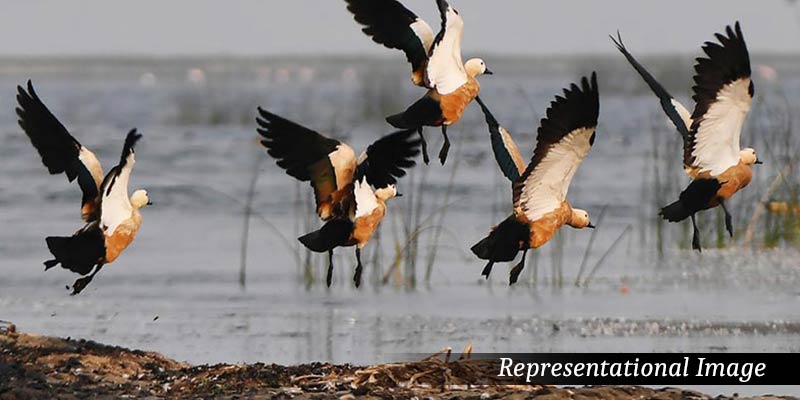- India
- Jun 08
Two bird sanctuaries of Bihar added to Ramsar list
• Two of Bihar’s wetlands — Nagi and Nakti bird sanctuaries — have been added to the global list of wetlands of international importance under the Ramsar Convention.
• With this, the total number of Ramsar sites in the country rose to 82.
• The Nagi and Nakti bird sanctuaries are located in Bihar’s Jamui district.
• These two wetlands are man-made reservoirs situated in the Jhajha forest range of Jamui.
• Both sites were declared as Wetlands of International importance on the occasion of World Environment Day on June 5.
Nakti Bird Sanctuary
Nakti Bird Sanctuary was developed primarily for irrigation through the construction of Nakti Dam. Since the dam’s construction, the wetland and its surrounding area have provided habitat for over 150 species of birds, mammals, fish, aquatic plants, reptiles and amphibians. They include globally threatened species, including the endangered Indian elephant (Elephas maximus indicus) and a vulnerable native catfish (Wallago attu). The catchment area is largely dry deciduous forest, and is surrounded by hills. In 1984, the wetland was designated as a Bird Sanctuary, highlighting its importance as a wintering habitat for several migratory species, with over 20,000 birds congregating during winter months. This includes one of the largest congregations of red-crested pochard (Netta rufina) on the Indo-Gangetic plain.
Nagi Bird Sanctuary
Nagi Bird Sanctuary was created following the damming of the Nagi River, which enabled the gradual formation of water bodies with clear water and aquatic vegetation. Due to its importance for migratory bird species, the Site was recognised locally as a Bird Sanctuary in 1984, and internationally as an Important Bird and Biodiversity Area (IBA) by BirdLife International. Overall, the wetland and its fringes provide habitat for over 75 bird species, 33 fish, and 12 aquatic plants. Notably, the site hosts one of the largest congregations of bar-headed geese (Anser indicus) on the Indo-Gangetic plain.
What is the Ramsar Convention?
• The Ramsar Convention is an international treaty signed by 172 countries to protect wetlands.
• It is named after the city in Iran where it was signed, and it began with 18 countries in 1971.
• The convention is one of the oldest inter-governmental accords for preserving the ecological character of wetlands. Also known as the Convention on Wetlands, it aims to develop a global network of wetlands for the conservation of biological diversity and for sustaining human life.
• It is one of the largest international agreements, after the Convention on Biological Diversity (CBD, 196 countries) and the UN climate agreement (UNFCCC, 197 countries).
• The Ramsar List is the world’s largest network of protected areas.
• There are over 2,400 Ramsar Sites around the world. The first Site was the Cobourg Peninsula in Australia, designated in 1974. The largest Sites are Rio Negro in Brazil (120,000 sq km), and Ngiri-Tumba-Maindombe in the Democratic Republic of Congo and Queen Maud Gulf in Canada. These Sites each cover over 60,000 sq km.
• The countries with the most Sites are the United Kingdom with 175 and Mexico with 142.
• In India, 82 wetlands covering an area of 1,332,739 hectares have been designated as Ramsar Sites of International Importance from India.
• The signatory countries promise to make inventories of their Ramsar Sites and to develop management plans. These management plans include the sustainable use of the many other functions of wetlands, such as food production, water storage and recreation.
What are wetlands?
• Wetlands are ecosystems, in which water is the primary factor controlling the environment and the associated plant and animal life.
• A broad definition of wetlands includes both freshwater and marine and coastal ecosystems, such as all lakes and rivers, underground aquifers, swamps and marshes, wet grasslands, peatlands, oases, estuaries, deltas and tidal flats, mangroves and even coral reefs. Fish ponds, rice paddies and salt-pans are man-made wetlands.
• These lands are critical to people and nature, given the intrinsic value of these ecosystems, and their benefits and services, including their environmental, climate, ecological, social, economic, scientific, educational, cultural, recreational and aesthetic contributions to sustainable development and human wellbeing.
• Wetlands are a major source of water and our main supply of freshwater comes from an array of wetlands which help soak rainfall and recharge groundwater.
• They sustain humanity, exemplified by rice grown on wetland paddies, a staple for three billion people, contributing to 20 per cent of global food.
• Additionally, wetlands act as natural shock absorbers, mitigating rainfall impacts and lowering flood and storm surge risks.
• Although they cover only around 6 per cent of the Earth’s land surface, 40 per cent of all plant and animal species live or breed in wetlands.
• Wetland biodiversity matters for our health, food supply, tourism and jobs.
• Wetlands are vital for humans, for other ecosystems and for our climate, providing essential ecosystem services, such as water regulation, including flood control and water purification.
• More than a billion people across the world depend on wetlands for their livelihoods – that’s about one in eight people on Earth.
Manorama Yearbook app is now available on Google Play Store and iOS App Store



